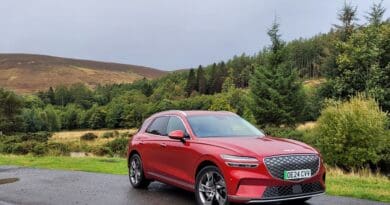2024 Ford Capri review: an icon reborn or a brand betrayal?
Is the new Ford Capri EV a true successor or an electric pretender to the classic coupe’s crown?
The legend is back, according to Ford.
That legend being the Ford Capri. The sleek two-door coupe of the 70s and 80s is back for the 21st century bringing – Ford says – ‘swagger, rebelliousness and a soulful sports car for the family’.
The use of the Capri name caused outrage when it was announced but Ford insists the new Capri is the car the icon was destined to become. Which is really stretching it. A rear-wheel-drive option aside, there’s not a lot of obvious similarities between the long low coupe and this chunky five-door crossover.
But does that really matter? Ford took dog’s abuse for recycling the Puma name for a compact SUV but it’s now the brand’s best-selling model and nobody cares about the sporty two-door oddity from the 1990s.
Die-hard badge fans aside, the use of the name is unlikely to sway many people one way or another, it’s how the car performs against Ford’s claims about it, and against rivals like the Volkswagen ID.5, Polestar 2 and Kia EV6 that really matters.
Design, interior and technology
We know that under the skin the Capri shares everything with the Explorer SUV but Ford’s design team has tried hard to set this fastback apart from that boxy model.
If you’re being cynical, you could dismiss the Capri as simply a sloped-roofed variant of the Explorer but it has been penned with enough differences from that boxy SUV to at least give the impression it’s a different car.
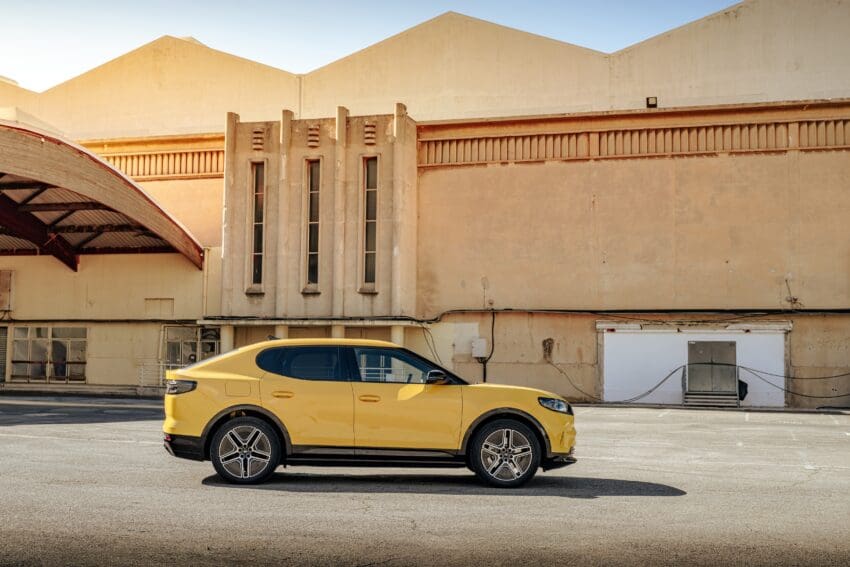
It’s longer and lower, for a start, but the angled, kinked rear end is the most immediately noticeable difference. It’s been designed to echo the tailgate line of the original, although it more closely resembles a Polestar 2. The front end also has its own character, with a lower bonnet edge and more slanting four-lamp headlights, which if you squint enough do recall the ‘face’ of the Mk1 Capri. And there’s an echo of the Capri’s famous C-shaped rear quarter light behind the rear doors.
These are all nods to the original coupe but there’s no escaping the tall, flat flanks and upright front and rear profiles which leave the Capri looking bloated and heavy.
While the outside has its own design, the interior is lifted virtually unchanged from the Explorer. Apart from some one-piece front seats, a few bits of faux carbon fibre trim and a steering wheel spoke inspired by the Mk1, the layout, materials and technology are the same.
That means a smattering of iffy VW switches hidden among an otherwise successfully executed cabin that looks and feels like a Ford. There’s decent space for four adults aboard and heaps of clever storage areas – from the configurable 17-litre ‘MegaConsole’, to the lockable hidden space behind the main touchscreen. There’s also an impressive 572 litres of boot space, which puts most other cars in this class to shame.
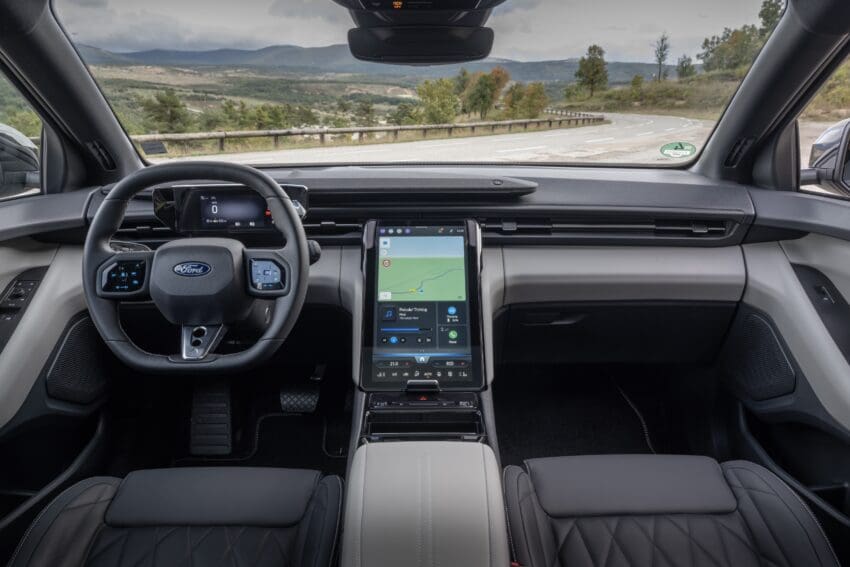
The 14.6-inch portrait screen runs on Ford’s Sync system and is clear and quick to respond to inputs. Like any modern infotainment system it takes a little getting used to but there are plenty of ways owners can customise shortcuts to suit their demands. Sadly there are no proper physical controls for pretty much anything, although things like temperature adjustment are permanently anchored to the bottom of the screen.
Instruments are also a digital affair, supplemented by a head-up display in higher-spec models. As you’d expect in this class, wireless smartphone mirroring is available if you don’t fancy using Ford’s own connected media and navigation systems.
Battery, motor and performance
Anyone familiar with the Explorer’s specification will recognise the Capri’s powertrain line-up.
Buyers get the choice of a single-motor rear-wheel-drive version with 282bhp and a 77kWh battery, or a two-motor all-wheel-drive setup with 335bhp and a 79kWh battery.
The lower-powered model offers the best range, despite its slightly smaller battery — up to 390 miles on a charge, compared with 368 miles for the two-motor option. Both are better than the equivalent Explorer or VW models, and the RWD is among the very best in its class.
The AWD, however, offers greater performance, cutting the 0-62mph time from a respectable 6.4 seconds to 5.3 seconds.
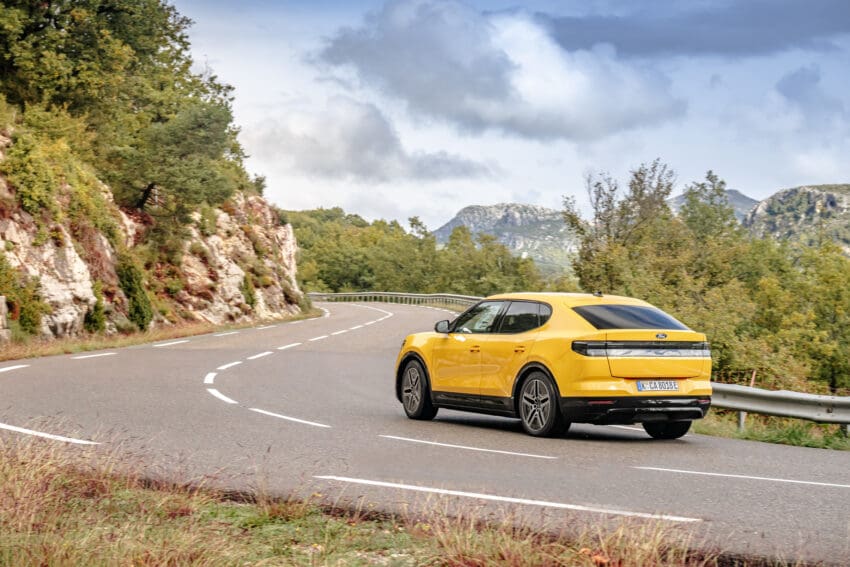
Even the RWD version feels sufficiently punchy and the AWD has some potent pace when you get aggressive with the throttle. But there’s more to a sporty car than pace and for all the bluster about swagger and sportiness, the Capri is too tall and heavy to be called sporty.
It’s 20mm lower than the Explorer but the car’s chassis chief was vague about what other differences there are, and it’s hard to discern much difference between the Capri’s driving character and that of the Explorer.
That’s not the end of the world. It’s still a decent handling car that turns in with more accuracy and willingness than some rivals and displays pleasingly levels body control. But there’s not enough substance or feel to the steering to back up any claims of a ‘sports car for the family’ and you’re still always aware of the height and weight.
It is at least impressively refined, both in ride and noise suppression, improving on the Explorer’s ability to smooth out bumpy surfaces and suppress wind noise even at higher speeds.
Price and specification
The Capri range is simple. There are just two trim levels — Select and Premium. Select is only available with the single-motor setup, while Premium can be specified in RWD or AWD configuration.
Prices start at £48,075 for the RWD Select, with a RWD Premium starting at £52,175. AWD Premium versions are another £4,000 on top of that.

Every version comes with 19-inch alloys, LED lights, keyless entry/go and adaptive cruise control. The 14.6-inch Sync system is also standard, as are heated seats, a heated steering wheel, a massaging driver’s seat and dual-zone climate control.
Premium spec adds 20-inch wheels, fully adaptive LED headlights, a panoramic sunroof, 10-speaker B&O sound system and ambient interior lighting.
However, a powered tailgate, head-up display, 360-degree camera and assisted lane change only come as part of the optional driver assistance package. And you’ll have to pay more than £1,000 extra for an efficiency-boosting heat pump.
Verdict
Ford feels like it’s trying too hard with the Capri. All the marketing bluster and proclamations that ‘life is too short for boring cars’ could, in the end, do more harm than good.
The Capri is not a bad car. Its looks are a little divisive but it does have some neat touches. Nor is it bad to drive. It’s quick, composed and impressively refined.
The problem is that it’s nowhere near the level of ‘soulful sports car’ the marketing guff is claiming. It’s a decent-driving SUV, just like the boxier Explorer.
Viewed as a direct successor to the Capri it’s a disappointment. Viewed as a sleeker, more unusual version of the practical and comfortable Explorer, it’s more of a success.
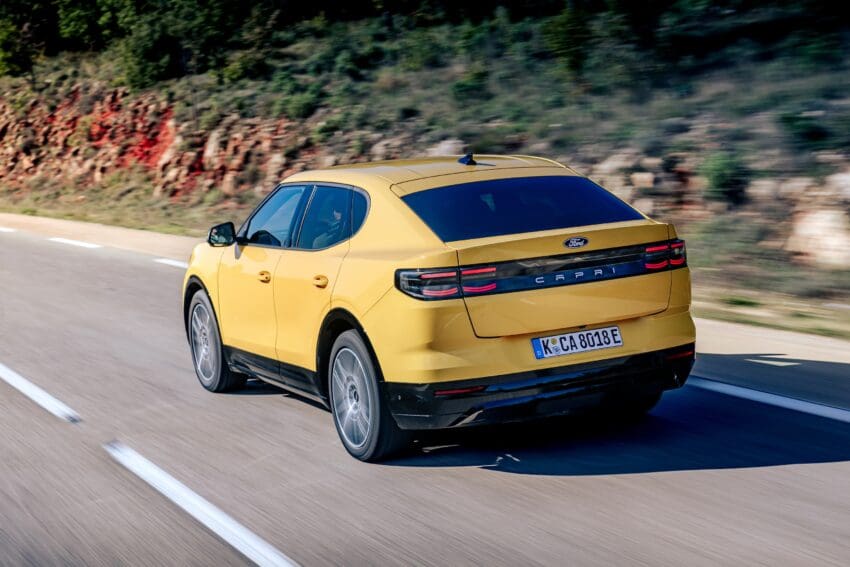
Ford Capri Premium
- Price: £56,175
- Powertrain: two-motor, all-wheel-drive
- Battery: 79kWh
- Power: 335bhp
- Torque: 501lb ft
- Top speed: 112mph
- 0-62mph: 5.3 seconds
- Range: 346 miles
- Consumption: 3.9m/kWh
- Charging: up to 185kW


